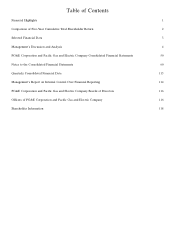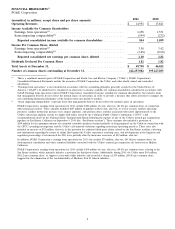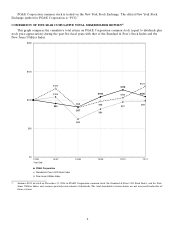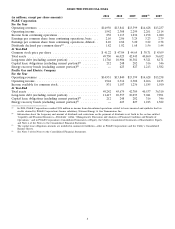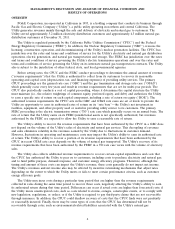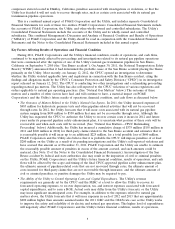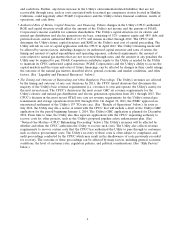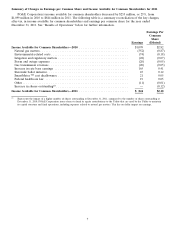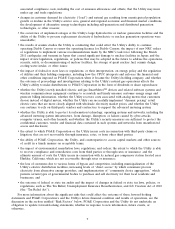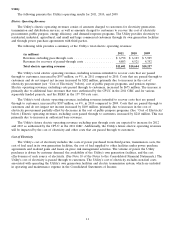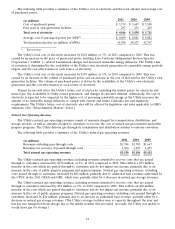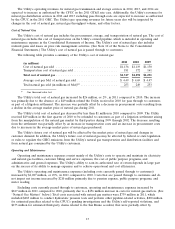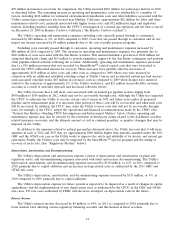PG&E 2011 Annual Report Download - page 8
Download and view the complete annual report
Please find page 8 of the 2011 PG&E annual report below. You can navigate through the pages in the report by either clicking on the pages listed below, or by using the keyword search tool below to find specific information within the annual report.MANAGEMENT’S DISCUSSION AND ANALYSIS OF FINANCIAL CONDITION AND
RESULTS OF OPERATIONS
OVERVIEW
PG&E Corporation, incorporated in California in 1995, is a holding company that conducts its business through
Pacific Gas and Electric Company (‘‘Utility’’), a public utility operating in northern and central California. The
Utility generates revenues mainly through the sale and delivery of electricity and natural gas to customers. The
Utility served approximately 5.2 million electricity distribution customers and approximately 4.3 million natural gas
distribution customers at December 31, 2011.
The Utility is regulated primarily by the California Public Utilities Commission (‘‘CPUC’’) and the Federal
Energy Regulatory Commission (‘‘FERC’’). In addition, the Nuclear Regulatory Commission (‘‘NRC’’) oversees the
licensing, construction, operation, and decommissioning of the Utility’s nuclear generation facilities. The CPUC has
jurisdiction over the rates and terms and conditions of service for the Utility’s electricity and natural gas distribution
operations, electric generation, and natural gas transportation and storage. The FERC has jurisdiction over the rates
and terms and conditions of service governing the Utility’s electric transmission operations and over the rates and
terms and conditions of service governing the Utility on its interstate natural gas transportation contracts. The Utility
also is subject to the jurisdiction of other federal, state, and local governmental agencies.
Before setting rates, the CPUC and the FERC conduct proceedings to determine the annual amount of revenue
(‘‘revenue requirements’’) that the Utility is authorized to collect from its customers to recover its reasonable
operating and capital costs (depreciation, tax, and financing expenses) of providing utility services. The primary
CPUC proceedings are the general rate case (‘‘GRC’’) and the gas transmission and storage rate case (‘‘GT&S’’)
which generally occur every few years and result in revenue requirements that are set for multi-year periods. The
CPUC also periodically conducts a cost of capital proceeding, where it determines the capital structure the Utility
must maintain (i.e., the relative weightings of common equity, preferred equity, and debt) and authorizes the Utility
to earn a specific rate of return on each capital component, including a rate of return on equity (‘‘ROE’’). The
authorized revenue requirements the CPUC sets in the GRC and GT&S rate cases are set at levels to provide the
Utility an opportunity to earn its authorized rates of return on its ‘‘rate base’’—the Utility’s net investment in
facilities, equipment, and other property used or useful in providing utility service to its customers. The primary
FERC proceeding is the electric transmission owner (‘‘TO’’) rate case which generally occurs on an annual basis. The
rate of return that the Utility earns on its FERC-jurisdictional assets is not specifically authorized, but revenues
authorized by the FERC are expected to allow the Utility to earn a reasonable rate of return.
The Utility’s ability to recover the revenue requirements that have been authorized by the CPUC in a GRC does
not depend on the volume of the Utility’s sales of electricity and natural gas services. This decoupling of revenues
and sales eliminates volatility in the revenues earned by the Utility due to fluctuations in customer demand.
However, fluctuations in operating and maintenance costs may impact the Utility’s ability to earn its authorized rate
of return. The Utility’s ability to recover a portion of its revenue requirements that have been authorized by the
CPUC in recent GT&S rate cases depends on the volume of natural gas transported. The Utility’s recovery of its
revenue requirements that have been authorized by the FERC in a TO rate case varies with the volume of electricity
sales.
The Utility also collects additional revenue requirements to recover certain capital expenditures and costs that
the CPUC has authorized the Utility to pass on to customers, including costs to purchase electricity and natural gas;
and to fund public purpose, demand response, and customer energy efficiency programs. Therefore, although the
timing and amount of these costs can impact the Utility’s revenue, these costs generally do not impact net income.
The Utility’s revenues and net income also may be affected by incentive ratemaking mechanisms that adjust rates
depending on the extent to which the Utility meets or fails to meet certain performance criteria, such as customer
energy efficiency goals.
The Utility may incur costs during a particular time period that are higher than the revenue requirements
collected in rates during the same time period to recover those costs, negatively affecting the Utility’s ability to earn
its authorized return during that time period. Differences can occur if actual costs are higher than forecasted costs; if
the Utility incurs unanticipated costs, such as costs related to storms, outages, catastrophic events, or to comply with
new legislation, regulations, or orders; or if the Utility is required to pay third-party claims that are not recoverable
through insurance. In addition, the CPUC could disallow recovery of costs that the CPUC finds were not prudently
or reasonably incurred. Finally, there may be some types of costs that the CPUC has determined will not be
recoverable through rates, such as environmental-related liabilities associated with the Utility’s natural gas
4



